
The Tanker Market in 1998
|
| THE CRUDE OIL TRANSPORT Chronicle of a crisis foretold
One parameter, among others, provides a fairly good summary of the cruel
situation with which the world of oil transport is again confronted: the average
time-charter equivalent of a VLCC on a Gulf / Europe voyage was approximately
US$38,000/day during the fourth quarter of 1997; it was only around $26,000/day in the
last quarter of 1998, a drop of more than 30%!
What has happened in such a short time to reverse so markedly the
indicators that were so promising in 1997? The optimism shown by the shipowners seems to
have been replaced by a sort of measured resignation today. It is effectively accepted
that 1999 (at least) will be a transition year during which each tanker category will
suffer from mediocre freight rates.
We should remember that at the same time in 1997 the protagonists of the
tanker sector were agreed in predicting high and sustained transaction values throughout
1998. This has not been the case, because the magnitude and the direct implications of the
Asian crisis in both economic and financial terms have not only affected the prices of
second-hand ships but also reduced trade to minimum levels, as we shall see below.
Before analyzing the prospects and the possible remedies for this
crisis, we shall attempt to verify this new degradation in balances and examine the
external factors contributing to its amplification.
The facts
In general, the VLCC and Suezmax sizes held up particularly well during
the first seven months of the year, despite often flagrant supply/demand imbalance. The
results of the Aframax units showed slow degradation throughout the year.
For all sizes combined, the bubble of illusion in which some were happy
to stay really burst from August on. The situation is better illustrated by the table
below:
Size |
Route |
Average TCE (USD) Jan-Jul |
Average TCE (USd) Aug-Dec |
VLCC |
AG/UKC |
33,165 |
27,030 |
Suezmax |
WAF/USG |
22,160 |
17,190 |
Aframax |
Cross
Med |
14,520 |
10,120 |
|
|
|
This is undeniably the category most affected by changes in external
economic factors. Dependent to a large extent (approximately 60%) on their routes to the
Far East, there was no doubt that the Asian crisis should have stopped the significant
increase in rates recorded in 1997. In fact, on the momentum generated in the preceding
months, the shipowners resisted until the summer!
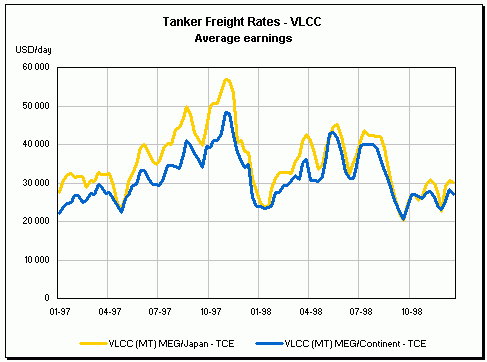
No doubt this was a consequence of a combination of psychological
factors, once again well orchestrated by the shipowners, and the slow introduction of
palliative measures taken by the countries affected by the Asian monetary and economic
crisis.
Over the same period, the tonnage supply continued to grow and was not
fully offset by the retirement of the oldest units.
| VLCCs delivered up to end July |
2,650,000 dwt (9 ships) |
| VLCCs scrapped up to end July |
1,697,000 dwt (6 ships) |
The decrease in demand for ships of more than 200,000 dwt outbound from
the Persian Gulf continued throughout the year: from around 25-30 ships chartered per week
over the first six months, the average fell to around 20-25 per week over the last six
months of the year.
In parallel, the tonnage supply at the end of 1998 attained the volume
shown below:
| UL/VLCC fleet on Jan 1, 1995 |
127,992,435 dwt (452 ships) |
| UL/VLCC fleet on Nov 25, 1998 |
128,261,120 dwt (445 ships) |
So, once again, confronted with the downturn in economic indicators
associated with insufficient scrapping and a growing trend toward shorter routes, the
largest ships are often the first victims. |
| The VLCC second-hand market Up to mid-December, 17 VLCCs have changed hands, excluding scrapping. This figure
is apparently similar to that of the previous year, since we recorded some twenty
transactions in 1997. However, that is as far as the comparison goes, because it should be
appreciated that more than two thirds of these transactions were concluded either as sales
with back or attached charters or purely for refinancing. This is probably why as many as
12 of the 17 VLCCs sold were less than 10 years old. An example is the M/T "Diamond
Bell", 243,500 dwt, built in 1989, single hull, sold in June for a price of around
$27,000,000 with a bareboat back charter running until October 1999. Elsewhere we noted
the sale of the M/Ts "Golar Stirling" and "Golar Glasgow", 302,000
dwt, both built in 1992, double sided, for $45,000,000 each with 3 years bareboat back
charter at around $21,000/day; similarly the M/T "Hyundai Diamond", 300,700 dwt,
built in 1998, was sold for $83,500,000 with 15 years bareboat back charter at
$25,000/day. This preference of the buyers to want to ensure their return on investment is
found in all the other ship categories, and is definitely one of the significant trends of
1998. Very few ships built in the 1970s changed hands, but we can nevertheless mention the
block sale to Greek buyers of the T/Ts "Sea Royal" and "Sea Majesty",
approximately 360,000 dwt, built in 1975 and 1977, for a price of $13,000,000.
Scrapping became active again and accelerated as the months passed. VLCC
scrapping for 1998 was back to a level similar to that observed in 1996, as up to
mid-December we recorded the departure of 16 units to the scrapping yards. We are still a
long way short of the 1995 figure (30 ships scrapped), but remember that only seven VLCCs
were scrapped in 1997. At present a reasonable estimate suggests that approximately 15
ships which have reached the 25-year limit remain in service, and that this figure will
increase by some 35 ships when the 1974 build is added in January 1999. This high number,
together with the decision of some oil companies not to use the old units in HBL mode,
should increase the rate of scrapping in 1999.
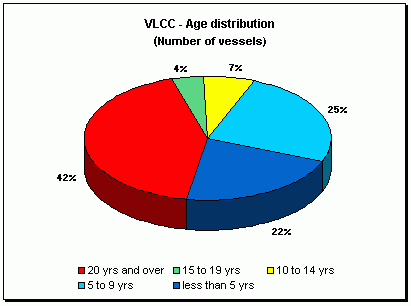
|
|
As they are in principle favored by the shortening of routes, these
units should be less sensitive to the factors that we have described above.
Analysis of the changes in average rates on a typical route shows that
this is not the case.
The globalization of economic phenomena and, in the present case, the
marked slowdown in the growth of the Western countries have affected this ship category
severely.
Traffic on the Arabian Gulf / East routes is decreasing considerably,
with the VLCCs conserving the lion’s share of a generally slack market. Only voyages
to China continue, pending facilitated access to this country for the large carriers.
In the Atlantic basin, the major balances between the West Africa,
Mediterranean and North Sea zones were relatively well maintained until July. The increase
in Iraqi crude exports through the Ceyhan terminal often acted as the "engine",
partly offsetting the lack of vigor of the traditional "locomotive", West
Africa.
The signs of weakness that appeared on the VLCC market soon lowered the
rates outbound from West Africa. There continues to be a high level of interdependence of
these two markets in this zone, where combinations of cargoes on the largest carriers are
frequent.
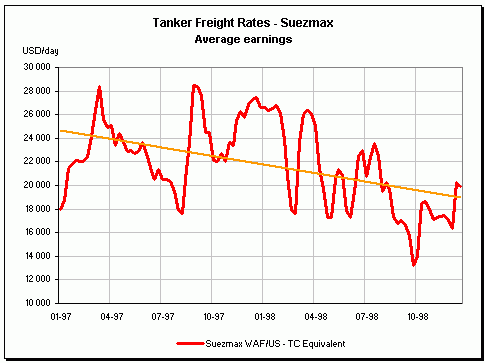
Moreover, the tonnage availability, and particularly that of old
tonnage, remains high, and the arrival of many new ships is still insufficiently
counterbalanced by voluntary scrapping.
| Suezmax fleet on Jan 1, 1995 |
48,552,044 dwt (363 ships) |
| Suezmax fleet on Nov 25, 1998 |
42,276,860 dwt (300 ships) |
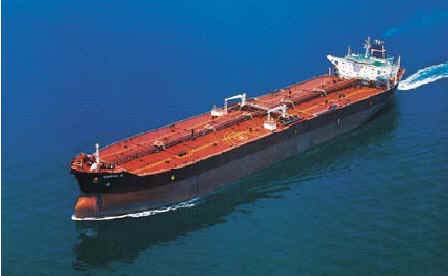 |
M/T Marina M 148,017
dwt, blt 1996 by Samsung,
owned by Eastern Mediterranean Maritime Ltd |
|
| The Suezmax second-hand market Whereas in 1997 up to the same date about 25 Suezmax had changed hands, at the
end of 1998 only 11 ship sales have been counted, including two for storage and one for
conversion to bow loader (the latter case involved the sale of the M/T "Tanana",
134,000 dwt, built in 1992, for approximately $45,600,000). The recorded sales were
divided more or less equally between the different years of construction, with four ships
less than 10 years old and the other seven having been built between 1974 and 1977. This
very low level of activity can be explained not only by the slump in the charter market
observed from the beginning of the year (in contrast to the VLCCs), but also because the
oldest ships are now condemned to earlier retirement, thus making them more difficult to
finance. Furthermore, the owners of more modern ships have not been inclined to align
their selling prices with the reduced prices quoted by the shipbuilders. We again see the
syndrome of refusal to face facts that we observed in 1997, when the shipowners were
finally forced to order new units because it was impossible to buy modern second-hand
tonnage at consistent prices (that is, prices likely to keep them competitive with those
who have chosen and are now choosing new building).
For information, we recall that in April the M/T "Ioannis",
149,999 dwt, built in 1989 and double-sided, was sold for a price of around $38,500,000,
whereas at the end of September the M/T "Celebes", 158,000 dwt, built in 1998,
was sold for approximately $48,000,000 with four years of back charter at $23,750/day. The
variations recorded all through the year in the time-charter equivalent obtained by the
owners of this class of tonnage certainly prevented them from having a clear vision of the
future prospects in this ship size, and contributed to the lukewarm interest shown in this
market segment.
As far as scrapping is concerned, no less than 12 units were sold,
including one ship built in 1969 which was used as an FPSO vessel and one unit which had
suffered a collision. About 28 Suezmax will attain their 25 th birth-day in 1999.
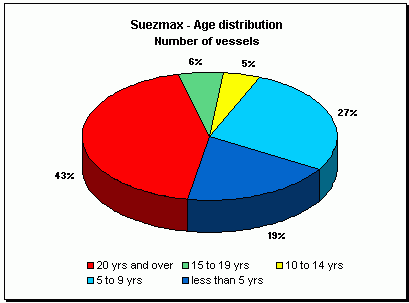
|
Shipping and Shipbuilding Markets 1999
I N D E X
|